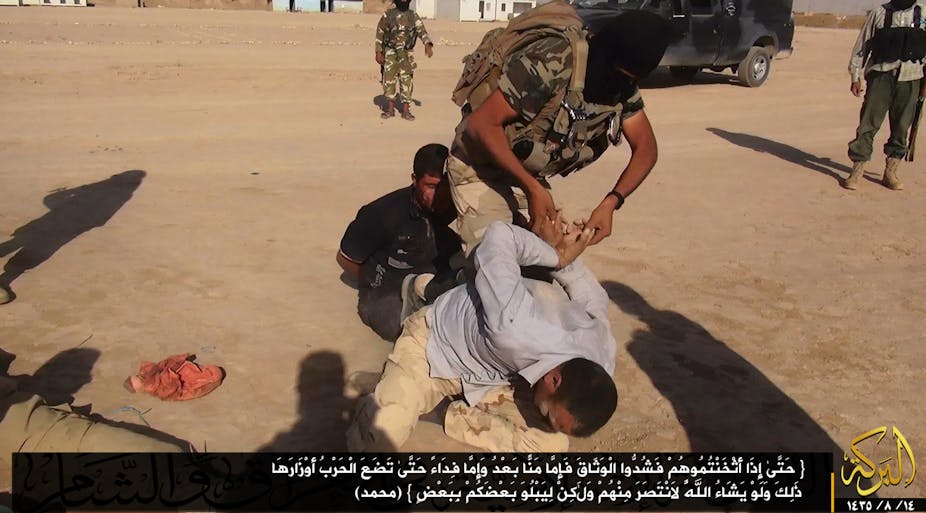This week Twitter began suspending accounts related to ISIS (Islamic State in Iraq and al-Sham). This follows an ISIS fighter reportedly posting the photo of the head of a decapitated Iraqi police major to #WorldCup, accompanied by the message “This is our ball. It is made of skin”.
This posting was one of images of hundreds of atrocities posted to social media, ranging from executions, public floggings, amputations and crucifixions. And such postings extend well beyond Twitter, with scores of videos of executions currently circulating on YouTube and other platforms, many with over 100,000 views.
It is urgent that we recognise the mutation of violence at work here. The executioners in Nazi death camps attempted to kill in secret, as did those responsible for the mass executions in Bosnia in the 1990s. Today’s extreme violence is not practised in secret, instead its authors seek maximum visibility. But there is more at stake here than propaganda. There is a new grammar of violence emerging, one closely associated with social media, in particular the way we all post photos and videos.
Masks as metaphor
The photos that circulate on social media are in the large majority about banal, day-to-day experience. We don’t “send messages” though photos, as understood in traditional ways of thinking about the media. Instead we create shared experience. In particular, we create forms of co-presence that are both virtual and intimate. This is why photos of food we are about to eat (often alone) are so important to social media, a legacy of the culture of the shared meal.
Photographs posted to social media don’t transmit a message, they share a sensation. This alerts us to critical dimensions of ISIS and its violence.
In the images coming out of Syria and Iraq, one striking feature is the importance of the mask. Almost all the accounts of the fighters entering Mosul last week make reference to their being masked. In the execution videos that circulate so widely, the killer is almost always masked while the victim is exposed and placed in extreme close-up.
The mask is primarily not a medium to hide identity. The masked person stands outside the relationships of visual exchange that constitute social life, outside the norms that shape our interactions. The mask is both a medium and a metaphor of transformation, with in many societies the wearing of masks a means to access unseen power. In Iraq and Syria the masked killer is accessing the power of al-Dawla (the term its supporters use to refer to ISIS) – the State.
Brutality
In a video posted to social media last year, and viewed by hundreds of thousands, a group of ISIS fighters pull over three lorry-drivers. These unarmed civilians are not simply killed, they are forced to squat on the ground, their identity cards presented to camera, and they are interrogated about the number of times to kneel during morning and noon prayers. Their inability to provide the correct answer proves they are Shia’, at which point they are taken to the side of the road and executed.
In another widely circulated video, a Shia’ Muslim is forced to recite prayers with a masked fighter holding a gun to his head – once he reaches the point where his phrasing demonstrates he is Shia’, the trigger is pulled.
The major beheaded last week was filmed in close-up while being forced to squat on the floor and admit to being a member of the police force. Only then does his interrogator stand behind him and cut off his head with a knife, the whole event filmed. The group of army reservists executed last week were first filmed lying on the floor, the camera again focusing on the face of each of those about to die.
All these killings possess a similar structure. The killer is masked, or such a great and feared leader that his power is clearly that of al-Dawla. The victim however is to be exposed, and through this a truth it to be revealed. In such violence, the humiliation of the victim and the frequent manipulation and exposure of the corpse are to establish that the person killed is less than human, as radically other.
Power game
Such violence is not the product of centuries of enmity, it is a uniquely modern phenomenon. Its horror is a sign that it stands outside human norms, just as the state it claims as the source of its extraordinary power.
What is absolutely striking is the pervasive presence of the camera phone, the close up image of the person to be killed, the intimacy of this killing despite its massive scale. The structure of this violence is one of the hidden and the revealed. It is embedded modern culture, shaped by breathless conspiracy theory and hidden enemies – central to the modern mutation that is jihadi culture.
Many observers have noted the unprecedented and massive role of social media in the war in Syria and increasingly now in Iraq. To understand the importance of social media we need to recognise that the camera phone does not simply film contemporary war, it plays an increasingly central role in shaping it. Recognising this is not only central to understand how al-Qaeda in Iraq, established by Abu Musab al-Zarqawi in 2004 and largely defeated by 2008, has now mutated into a group controlling large parts of Syria and Iraq.
It is also at the heart of understanding the power that such violence exercises on the thousands of fighters who have joined this war from other parts of the world, often as a result of encountering it through social media.

